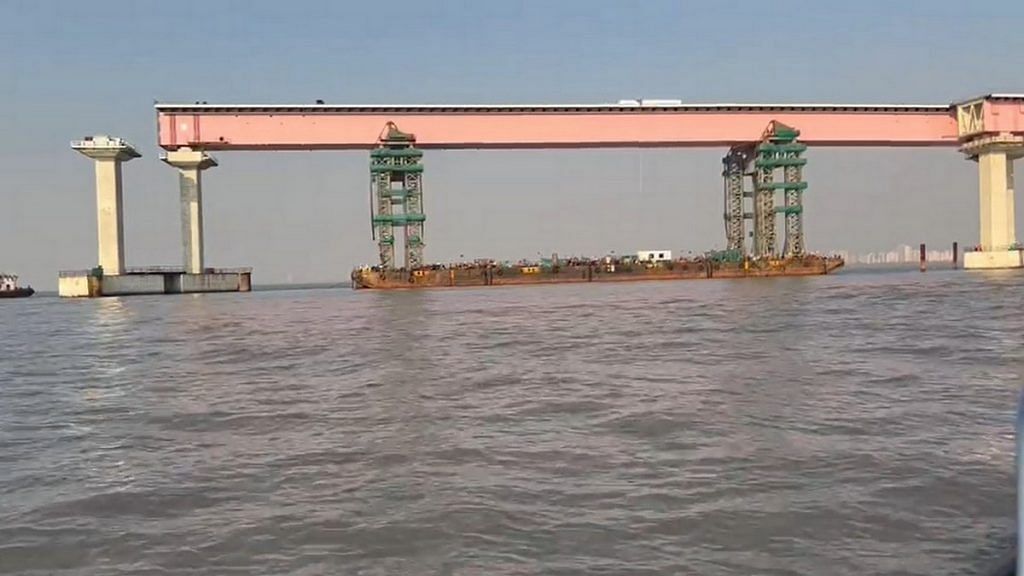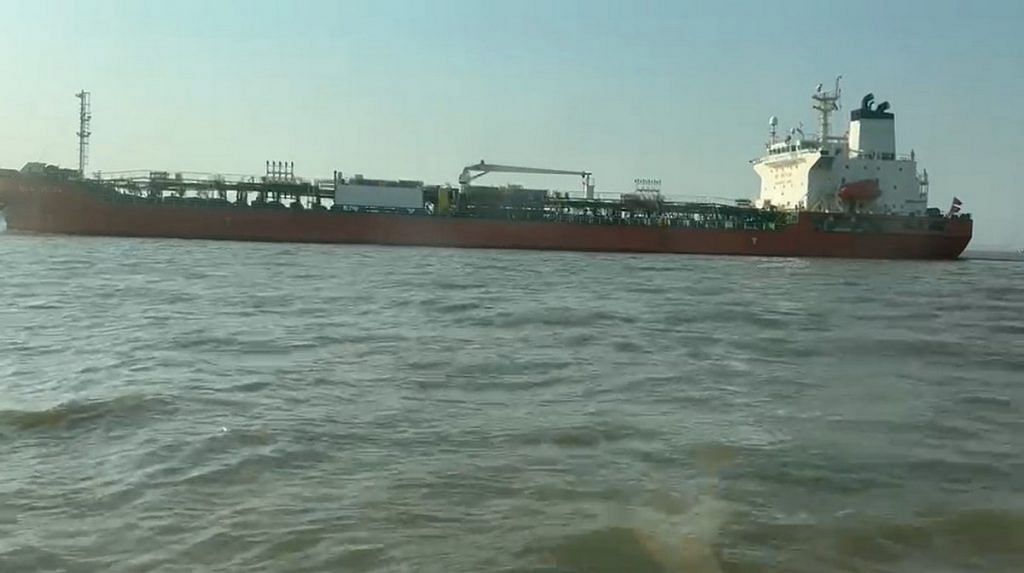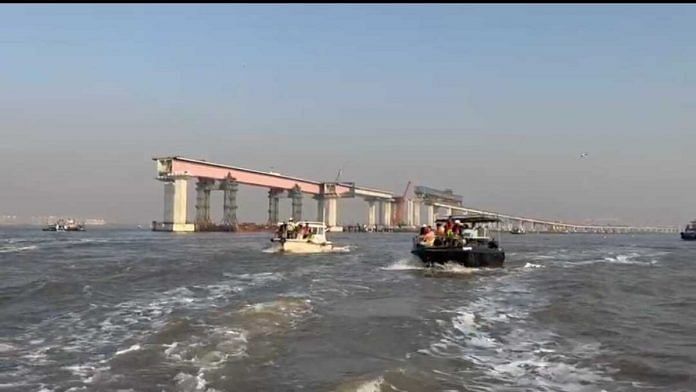Mumbai: A massive barge sailed into Mumbai harbour, bearing extraordinary cargo: a pale pink bridge deck that had been fabricated in four different countries, weighed about as much as 300 elephants, and required several towering cranes to hold it up.
This Wednesday afternoon, the 2,300-metric tonne deck was lowered between Pier 184 and 185 of the under-construction Sewri-Nhava Sheva Mumbai Trans-Harbour Link (MTHL). It was a milestone, not just for the showpiece project or Mumbai but also generally for India’s engineering and construction prowess.
The 22-km MTHL, touted as India’s longest sea link, will connect Sewri in peninsular South Mumbai to Nhava Sheva in mainland Navi Mumbai. By offering speedy transit between the two parts of the city, it promises to unlock the commercial and residential potential of the mainland, and will be a key connector to the under-construction Navi Mumbai International Airport.
The Rs 17,843-crore link is inching closer to completion, span by span, towards its December 2023 deadline. And in the process, it is is marking many firsts in India’s construction sector, the engineers and officials involved in the project say.
One of these firsts, for India at least, is the use of orthotropic steel decks (OSDs). These special steel decks enable a span, or distance between two piers, that’s up to three times longer than the norm, and are being used in stretches that are navigational channels for large ships.
The humongous pink slab that reached its final destination this week was, at 180 metres, the longest OSD used yet, making its precise launch even more significant, engineers working on the project said.

“About 85 to 90 per cent of the civil work (structural work) is complete and we are on track to meet the December 2023 deadline,” S.V.R Srinivas, commissioner at the Mumbai Metropolitan Region Development Authority (MMRDA), the state government agency in charge of the project, told ThePrint.
“Many of the engineering technologies used in this project have been deployed in India for the first time, and for everything, we have had to exercise a lot of caution. Even one small error can be colossal and set the project back,” he added.
The MTHL was first conceived nearly two decades ago as a link across the Mumbai harbour that could spur development on the mainland by improving its connectivity with the island city — much like Kowloon across the Victoria Harbour in Hong Kong.
Between 2005 and 2011, there were three attempts to bid out the project, but all fell through due to some reason or the other.
In 2016, the Maharashtra government secured funding for the project from the Japan International Cooperation Agency (JICA) and awarded fresh contracts for the link in 2017. Construction eventually started in 2018.
Also Read: Infra projects to boost connectivity in 129 villages around Mumbai, MMRDA wants planning rights
One span at a time
The OSDs are fabricated in panels of 12 metres each in Japan, South Korea, Vietnam, and Myanmar before they are brought to the Karanja Port at Uran in Navi Mumbai for assembly.
The longer spans that these decks give are important for large ships to be able to pass through navigation channels without difficulty.
While a regular span on the MTHL is 60 metres, with the use of OSDs, the MMRDA has planned for spans ranging from 80 to 180 metres.
Every few days, a barge carrying an OSD sets sail from Karanja Port, pulled by a tug boat.
“We can move the barge only in high waters, so we have to be very careful about the tide timings. We take advantage of the tide pushing us whenever possible and move at a very slow speed,” a marine logistics expert advising on the project told ThePrint. Even if the engineers catch the favourable tide, it takes about seven or eight hours for the barge to reach the site location, he said.

The barge measures 100 x 36 metres and weighs 1,300 metric tonnes. Srinivas said there are three such barges that are ferrying the steel decks simultaneously.
Wednesday’s launch was the 36th of the 70 OSDs that are being used in the project, covering about 4 km of the harbour link’s 22-km length. For the rest of the distance, girders are being used.
“We should be able to finish launching all OSDs by August. On the remaining 18 km too, we have finished launching 90 per cent of the girders,” Srinivas said.
After this, contractors will install crash barriers along the entire length, vision barriers at the part of the sea link along the sensitive Bhabha Atomic Research Sector, noise barriers at certain places, and then top the road with bitumen and install a tolling system before the MTHL is fully ready to be commissioned for public use.
Crash barriers are the metal fences found at the side of roads to reduce the risk of serious accidents. Vision barriers are uninterrupted structures also found along the side of roads to help block the line sight on either side of the road.
The tolling system is likely to be an Open Road Toll (ORT) without any boom barriers to prevent long queues, Chief Minister Eknath Shinde, who went to the site of the OSD’s launch Wednesday, told reporters.
A project of firsts
The country’s longest sea link has clocked a lot of firsts besides the complex-to-launch OSDs.
For years environmentalists were at odds with the MTHL proposal fearing that the raucous construction activity would drive away the migratory flamingos that make an annual appearance at the Sewri mudflats from December to May.
For this, the MTHL team deployed a method called ‘Reverse Circulation Drilling’ (RCD) for pile foundations — the first time the technique was used for any project in India — Srinivas told ThePrint.
“Putting pile foundations in place is the most time-consuming activity in any project. Normally, we resort to vertical drilling with piling machines which creates tremendous noise. Such heightened noise continuously for four years would have disturbed the habitat of the flamingos. RCD minimises construction noise,” Srinivas said.
“That is one of the secrets behind the flamingos coming back year after year despite the construction activity,” he added.
The MMRDA also plans to use special high-containment crash barriers from South Korea. An engineer working on the project who did not wish to be named told ThePrint: “Regular crash barriers just take the impact of a crash, but since this is the sea, we wanted to take every precaution to avoid any untoward incident. The high containment crash barriers will push the car back on the road”.
This too, the engineer said, is an experiment new to Indian roads.
(Edited by Uttara Ramaswamy)
Also Read: 4x labour, more shifts & meetings — why Mumbai’s trans-harbour link might just meet 2023 deadline



